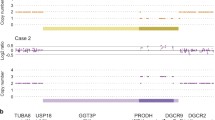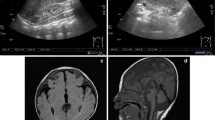Abstract
DiGeorge syndrome (DGS) is a developmental field defect of the third and fourth pharyngeal pouches that are associated with congenital heart defects, hypoparathyroidism, cell-mediated immunodeficiency, velopharyngeal insufficiency, and craniofaial anomalities. Approximately 90% of patients exhibit monosomy in the 22q11 region. In order to isolate the critical gene responsible for DGS, the cDNA libraries were screened with a probe containing the ADU balanced translocation break point, that is a locus reported in one patient (ADU) caused by a balanced translocation between chromosomes 22 and 2. Out of 106 clones, three independent overlapping clones were isolated, which were assumed to have originated from a single transcript, DGCR7. This transcript contained a 175-aa long open reading frame (ORF), encoding an acidic (pI=5.81) and a proline-rich peptide, which are often found in the activation domain of several transcription factors. Also, it was predicted to be a nuclear protein. Northern hybridization detected an approx 1.9 kb transcript in all fetal and adult tissues tested, with strong expression in the fetal liver and kidney. In the case of adult tissues, strong expression was also detected in areas such as the heart, skeletal muscle, liver, and kidney.
Similar content being viewed by others
References
Muller, W., Peter, H. H., Wilken, M., et al. (1988) The DiGeorge syndrome. I. Clinical evaluation and course of partial and complete forms of the syndrome. Eur. J. Pediatric. 147, 496–502.
Kirby, M. L. and Waldo, K. L. (1990) Role of neural crest in congenital heart disease. Circulation 82, 332–340.
Demczuk, S. and Aurias, A. (1995) DiGeorge syndrome and related syndromes associated with 22q11. 2 deletions. Ann. Genet. 38, 59–76.
Augusseau, S., Jouk, S., Jalbert, P., and Prieur, M. (1986) DiGeorge syndrome and 22q11 rearrangements. Hum. Genet. 74, 206.
Baldini, A. (1999) Is the genetic basis of DiGeorge syndrome in HAND? Nature Genetics 21, 246–247.
Budarf, M. L., Collins, J., Gong, W., et al. (1995) Cloning a balanced translocation associated with DiGeorge syndrome and identification of a disrupted candidate gene. Nature Genet. 10, 269–278.
Sutherland, H. F., Wadey, R., McKie, J. M., et al. (1996) Identification of a novel transcript disrupted by a balanced translocation associated with DiGeorge syndrome. Am. J. Hum. Genet. 59, 23–31.
Sambrook, J., Fritsch, E. F., and Maniatis, T. (1989) Molecular Cloning: A Laboratory Manual, 2nd ed., Cold Spring Harbor Laboratory, Cold Spring Harbor, NY.
Hur, H., Kim, Y. J., Noh, C. I., Seo, J.-W., and Kim, M. H. (1999) Molecular genetic analysis of the DiGeorge syndrome among Korean patients with congenital heart disease. Mol. Cells 9, 72–77.
Sigler, P. B. (1988) Transcriptional activation. Acid blobs and negative noodles. Nature 333, 210–212.
Mitchell, P. J. and Tjian, R. (1989) Transcriptional regulation in mammalian cells by sequence-specific DNA binding proteins. Science 245, 371–378.
von der Ahe, D., Pearson, D., Nakagawa, J.-i., Rajput B., and Nagamine Y. (1988) Multiple nuclear factors interact with promoter sequences of the urokinase-type plasminogen activator gene. Nucleic Acids Res. 16, 7527–7544.
Imagawa, M., Chiu, R., and Karin, M. (1987) Transcription factor AP-2 mediates induction by two different signal-transduction pathways: protein kinase C and cAMP. Cell 51, 251–260.
Yamagishi, H., Grag, V., Matsuoka, R., Thomas, T., and Srivastava, D. (1999) A molecular pathway revealing a genetic basis for human cardiac and craniofacial defects. Science 283, 1158–1161.
Baldwin, T. J. and Burden, S. J. (1989) Muscle-specific gene expression controlled by a regulatory element lacking a MyoD1-binding site. Nature 341, 716–720.
Author information
Authors and Affiliations
Corresponding author
Rights and permissions
About this article
Cite this article
Kim, M.H., Hur, H., Park, J. et al. Isolation of novel cDNA encompassing the ADU balanced translocation break point in the DiGeorge critical region. Mol Biotechnol 17, 213–217 (2001). https://doi.org/10.1385/MB:17:3:213
Issue Date:
DOI: https://doi.org/10.1385/MB:17:3:213




